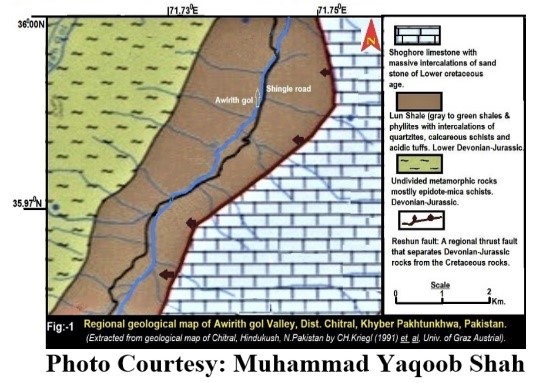INP-WealthPk
Faiza Tehseen
The Awireth and Sewakht valleys in the Chitral district of Khyber Pakhtunkhwa house a wealth of gold, silver and other precious minerals. A successful Green Field Exploration (GFE) can transform the area’s socio-economic dilemma into a prosperous vision, said Muhammad Yaqoob Shah, Principal Geologist at the Global Mining Company Limited, Islamabad, while talking to WealthPK.
The mineral-rich valleys are located opposite each other along the almost 165Km Reshun Thrust Fault (RTF) at a linear distance of around 37 kilometres. These landmarks are rich in antimony, galena, gold, silver, copper and lead in a combined form in a rock called boulangerite.

Yaqoob Shah, who also served as GM Pakistan Mineral Development Corporation (PMDC), said boulangerite is a unique monoclinic orthorhombic sulfosalt group of minerals. Normally, it is found in bluish, dark grey, and black hues mainly composed of antimony and lead, and commonly occurs with antimony and galena in low to medium-temperature hydrothermal veins and stock works. Commonly, associated minerals with boulangerite are pyrite, arsenopyrite, sphalerite, quartz, and siderite.
Yaqoob recalled that during the mining of galena and antimony in 1974-75, boulangerite was found in the Chitral district. The USGS geologists investigated these findings in 1980-81. The targeted area for the said prospect was the Awireth and Sewakht valleys located opposite each other across the Luthko valley near the Shoghore village. There mineralization of boulangerite occurs as hydrothermal veins and lenticular bodies along Reshun Fault zones and corresponding faults zones.
The Reshun Fault is a regional thrust that intersects the entire Karakoram terrain longitudinally by separating the Devonian-Jurassic rocks. Starting from Drosh (southern most area), it passes through Sewakht and Awireth valleys up to Shah Jinali Pass (the extreme northeastern side). Towards the eastern side of Broghal valley, about 165km away from its origin, the said fault is concealed under the soil cover.
In Awireth valley along with a local shear zone, a 12-meter long and 1.2-meter wide boulangerite bearing vein was examined by the USGS geologists. The analysis report in this vein (published in 1981) strongly indicated the presence of gold and silver from rocks mainly composed of fine-grained lead antimony sulfide with accessory chalcopyrite and pyrite. In some places, yellowish-stained arsenic and green-coloured malachite ore were found along with small amounts of vanadium, tin, and other metals.
Continuing the discussion, Yaqoob Shah said during 1988-89, Austrian geologist Dr. H. Gamerith re-analyzed the area and concluded the dominant metal content average as lead 38%, antimony 14%, silver 470 g/t, and gold 50g/t. Native gold and silver grains (10-20 microns in size) were found in sulfide fractures as isolated grains, and quartz, dolomite, and calcite as the main gangue minerals.
Later, research performed by the Centralized Research Laboratories (CRL), University of Peshawar, and other reputed geo-labs in impregnated altered pyrite disseminated zone and a quartz vein showed slight traces of boulangerite mineralization. Surprisingly, there are strong indications of occurrence of anomalous values of gold and silver even in areas showing weak signs of boulangerite-bearing veins, said Added Muhammad Yaqoob Shah, who is also an active member of the National Council for Marble & Granite and minerals.
Credit: Independent News Pakistan-WealthPk



